Carleton University ECON 3360A Assignment 1 Analysis of Employment
VerifiedAdded on 2022/08/16
|7
|1161
|12
Homework Assignment
AI Summary
This assignment provides solutions to an economics assignment for ECON 3360A at Carleton University, focusing on labour economics. The solution includes an analysis of employment rates among Canadian youth, examining seasonality and the impact of the 2008 financial crisis. It also explores worker preferences and marginal rates of substitution, analyzing how workers choose between different hours of work and the implications of moonlighting. Furthermore, the assignment addresses income policy, specifically wage subsidies and tax credits, with a detailed look at the Earned Income Tax Credit (EITC) and its effects on labor market participation, designed to increase the number of hours a low-wage worker works. The document references Statistics Canada data and relevant academic sources.
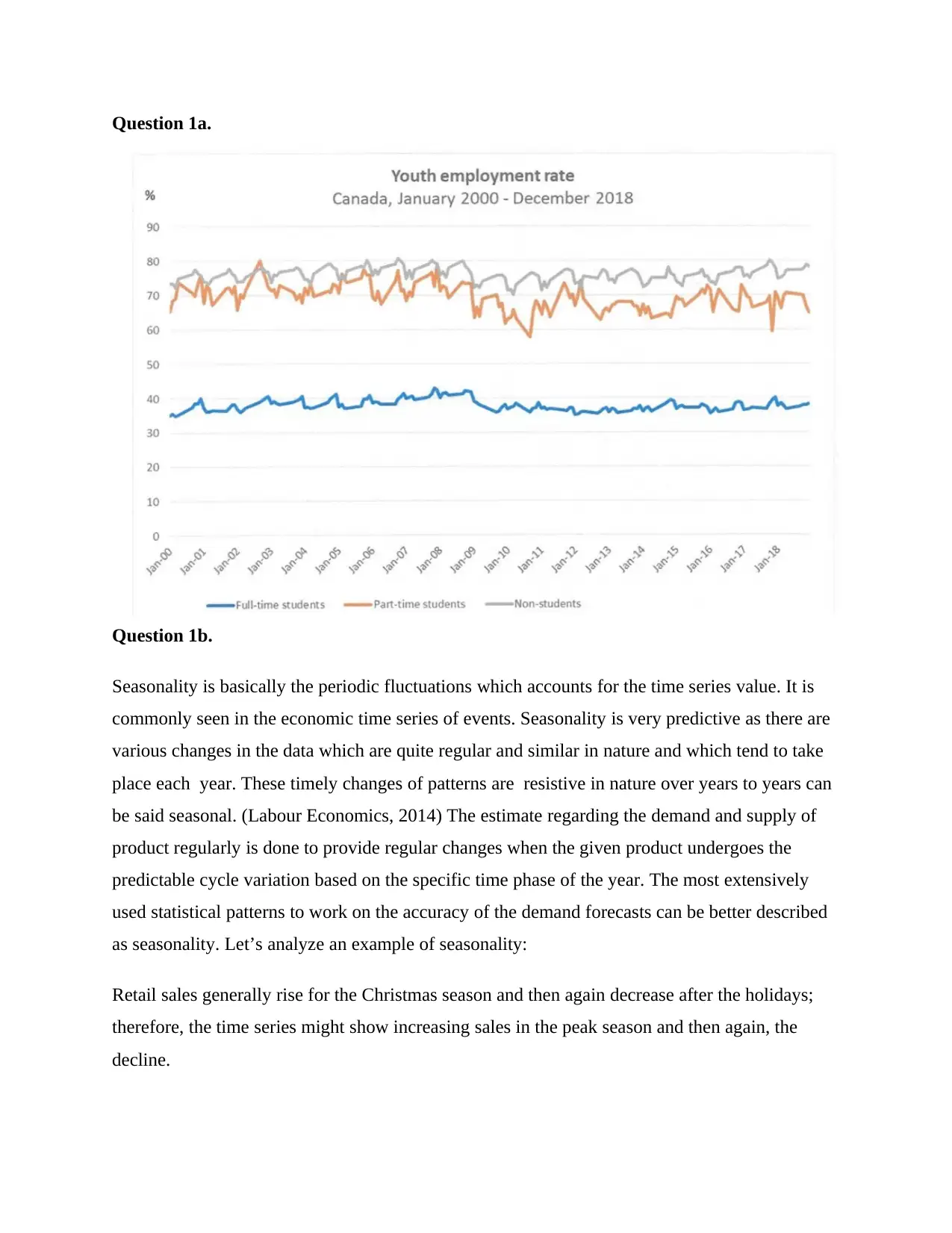
Question 1a.
Question 1b.
Seasonality is basically the periodic fluctuations which accounts for the time series value. It is
commonly seen in the economic time series of events. Seasonality is very predictive as there are
various changes in the data which are quite regular and similar in nature and which tend to take
place each year. These timely changes of patterns are resistive in nature over years to years can
be said seasonal. (Labour Economics, 2014) The estimate regarding the demand and supply of
product regularly is done to provide regular changes when the given product undergoes the
predictable cycle variation based on the specific time phase of the year. The most extensively
used statistical patterns to work on the accuracy of the demand forecasts can be better described
as seasonality. Let’s analyze an example of seasonality:
Retail sales generally rise for the Christmas season and then again decrease after the holidays;
therefore, the time series might show increasing sales in the peak season and then again, the
decline.
Question 1b.
Seasonality is basically the periodic fluctuations which accounts for the time series value. It is
commonly seen in the economic time series of events. Seasonality is very predictive as there are
various changes in the data which are quite regular and similar in nature and which tend to take
place each year. These timely changes of patterns are resistive in nature over years to years can
be said seasonal. (Labour Economics, 2014) The estimate regarding the demand and supply of
product regularly is done to provide regular changes when the given product undergoes the
predictable cycle variation based on the specific time phase of the year. The most extensively
used statistical patterns to work on the accuracy of the demand forecasts can be better described
as seasonality. Let’s analyze an example of seasonality:
Retail sales generally rise for the Christmas season and then again decrease after the holidays;
therefore, the time series might show increasing sales in the peak season and then again, the
decline.
Paraphrase This Document
Need a fresh take? Get an instant paraphrase of this document with our AI Paraphraser

Question 1c.
Severe economic downturn (the Great Recession) after the 2008 financial crisis can be
considered for better understanding of the employment rate pattern across all the three divisions
after the year 2008.
Question 1d.
The difference in the average employment rates over the seasonality time period between the
non-students, part time students and full-time students can be well explained by the full-time
students as they select not to work while studying. Whereas, the part time and non-students work
to earn while studying.
Question 2.
Severe economic downturn (the Great Recession) after the 2008 financial crisis can be
considered for better understanding of the employment rate pattern across all the three divisions
after the year 2008.
Question 1d.
The difference in the average employment rates over the seasonality time period between the
non-students, part time students and full-time students can be well explained by the full-time
students as they select not to work while studying. Whereas, the part time and non-students work
to earn while studying.
Question 2.
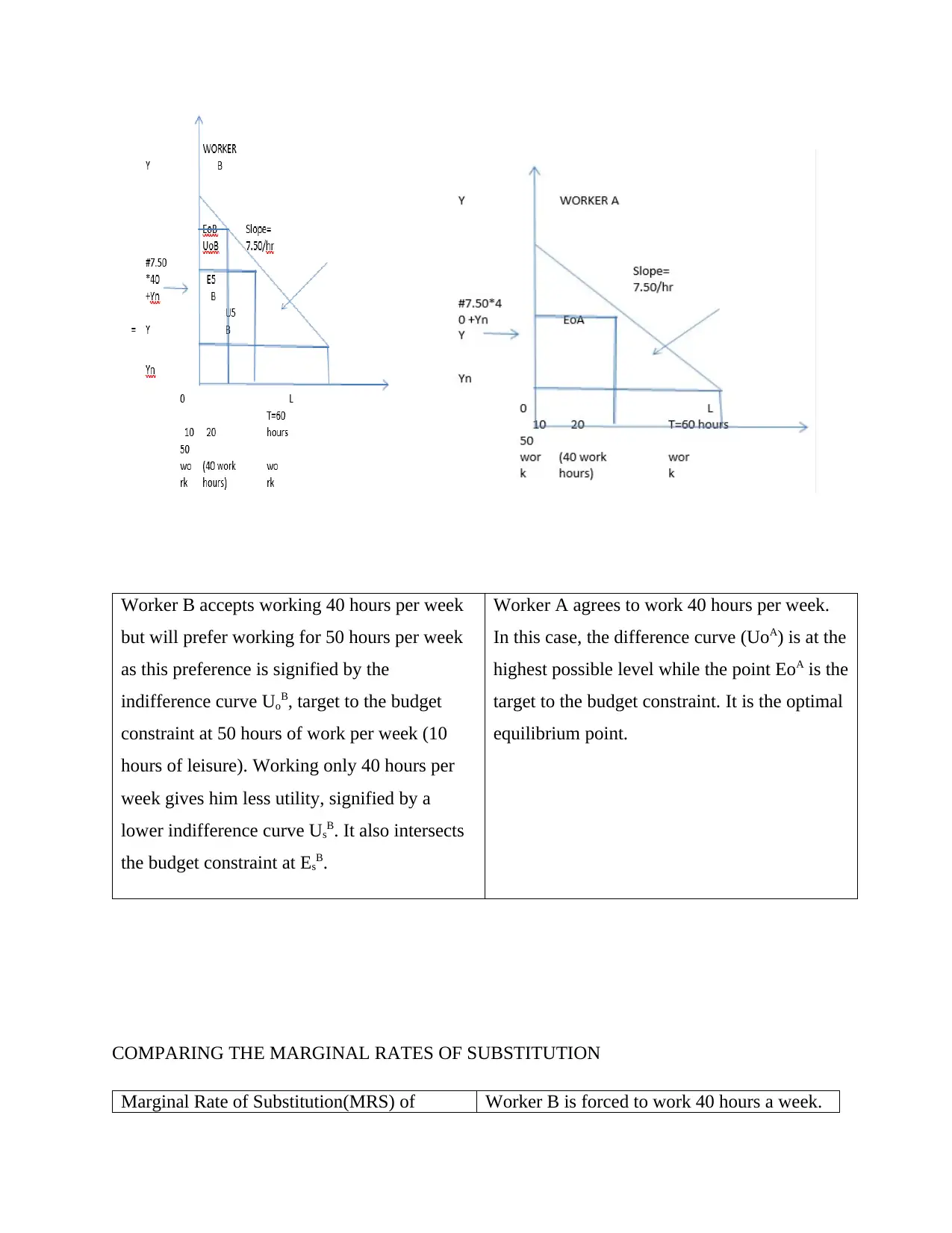
Worker B accepts working 40 hours per week
but will prefer working for 50 hours per week
as this preference is signified by the
indifference curve UoB, target to the budget
constraint at 50 hours of work per week (10
hours of leisure). Working only 40 hours per
week gives him less utility, signified by a
lower indifference curve UsB. It also intersects
the budget constraint at EsB.
Worker A agrees to work 40 hours per week.
In this case, the difference curve (UoA) is at the
highest possible level while the point EoA is the
target to the budget constraint. It is the optimal
equilibrium point.
COMPARING THE MARGINAL RATES OF SUBSTITUTION
Marginal Rate of Substitution(MRS) of Worker B is forced to work 40 hours a week.
but will prefer working for 50 hours per week
as this preference is signified by the
indifference curve UoB, target to the budget
constraint at 50 hours of work per week (10
hours of leisure). Working only 40 hours per
week gives him less utility, signified by a
lower indifference curve UsB. It also intersects
the budget constraint at EsB.
Worker A agrees to work 40 hours per week.
In this case, the difference curve (UoA) is at the
highest possible level while the point EoA is the
target to the budget constraint. It is the optimal
equilibrium point.
COMPARING THE MARGINAL RATES OF SUBSTITUTION
Marginal Rate of Substitution(MRS) of Worker B is forced to work 40 hours a week.
⊘ This is a preview!⊘
Do you want full access?
Subscribe today to unlock all pages.

Trusted by 1+ million students worldwide
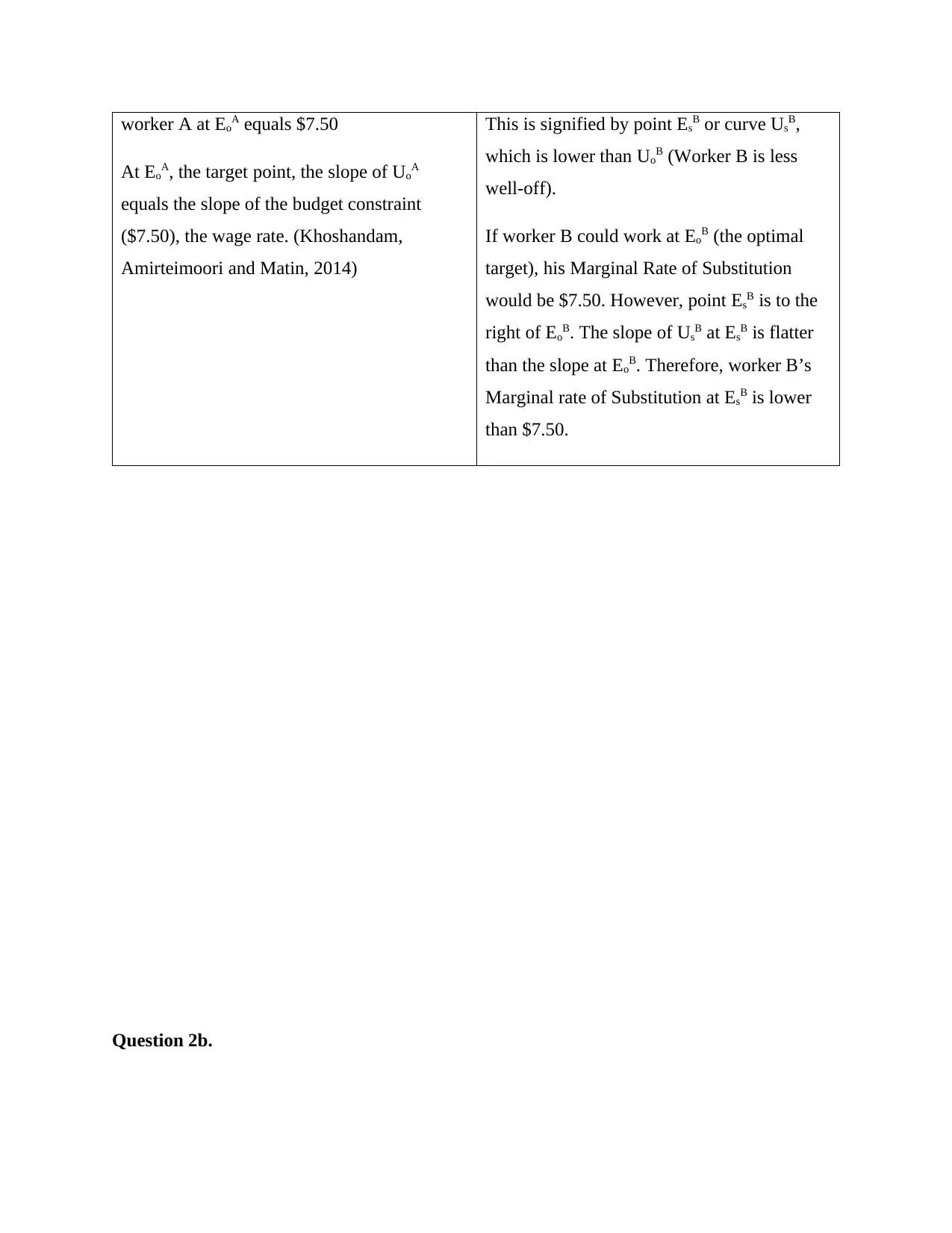
worker A at EoA equals $7.50
At EoA, the target point, the slope of UoA
equals the slope of the budget constraint
($7.50), the wage rate. (Khoshandam,
Amirteimoori and Matin, 2014)
This is signified by point EsB or curve UsB,
which is lower than UoB (Worker B is less
well-off).
If worker B could work at EoB (the optimal
target), his Marginal Rate of Substitution
would be $7.50. However, point EsB is to the
right of EoB. The slope of UsB at EsB is flatter
than the slope at EoB. Therefore, worker B’s
Marginal rate of Substitution at EsB is lower
than $7.50.
Question 2b.
At EoA, the target point, the slope of UoA
equals the slope of the budget constraint
($7.50), the wage rate. (Khoshandam,
Amirteimoori and Matin, 2014)
This is signified by point EsB or curve UsB,
which is lower than UoB (Worker B is less
well-off).
If worker B could work at EoB (the optimal
target), his Marginal Rate of Substitution
would be $7.50. However, point EsB is to the
right of EoB. The slope of UsB at EsB is flatter
than the slope at EoB. Therefore, worker B’s
Marginal rate of Substitution at EsB is lower
than $7.50.
Question 2b.
Paraphrase This Document
Need a fresh take? Get an instant paraphrase of this document with our AI Paraphraser
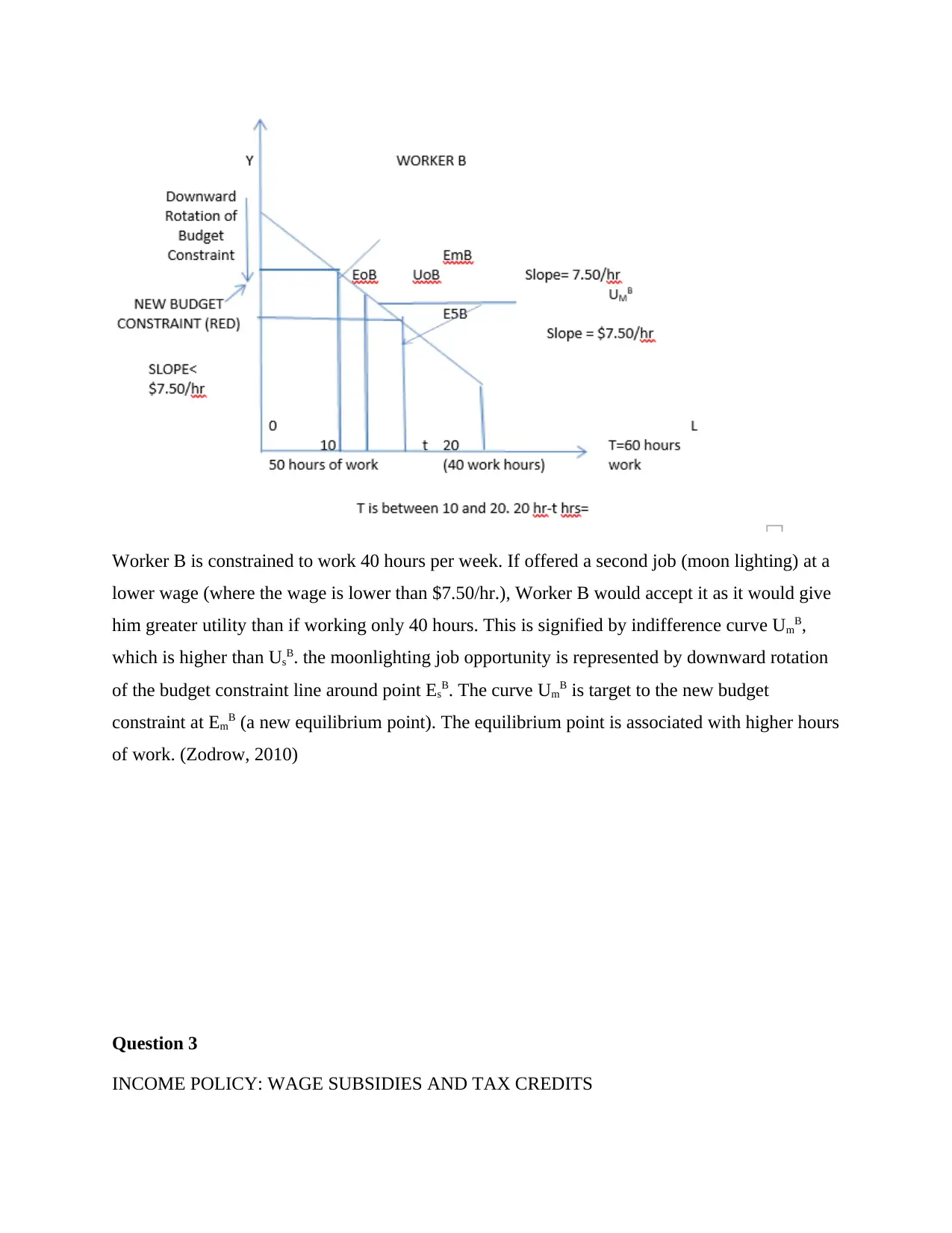
Worker B is constrained to work 40 hours per week. If offered a second job (moon lighting) at a
lower wage (where the wage is lower than $7.50/hr.), Worker B would accept it as it would give
him greater utility than if working only 40 hours. This is signified by indifference curve UmB,
which is higher than UsB. the moonlighting job opportunity is represented by downward rotation
of the budget constraint line around point EsB. The curve UmB is target to the new budget
constraint at EmB (a new equilibrium point). The equilibrium point is associated with higher hours
of work. (Zodrow, 2010)
Question 3
INCOME POLICY: WAGE SUBSIDIES AND TAX CREDITS
lower wage (where the wage is lower than $7.50/hr.), Worker B would accept it as it would give
him greater utility than if working only 40 hours. This is signified by indifference curve UmB,
which is higher than UsB. the moonlighting job opportunity is represented by downward rotation
of the budget constraint line around point EsB. The curve UmB is target to the new budget
constraint at EmB (a new equilibrium point). The equilibrium point is associated with higher hours
of work. (Zodrow, 2010)
Question 3
INCOME POLICY: WAGE SUBSIDIES AND TAX CREDITS
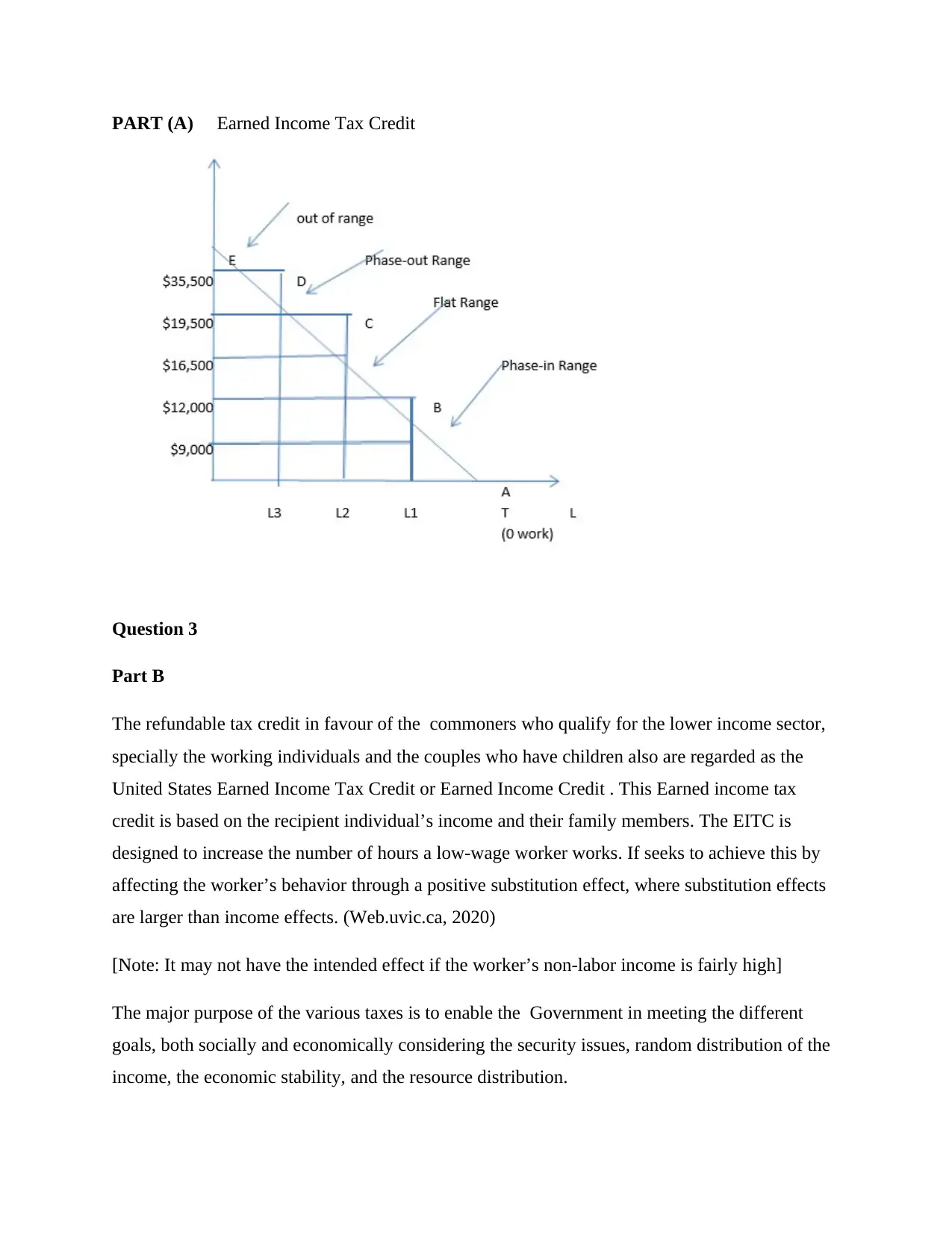
PART (A) Earned Income Tax Credit
Question 3
Part B
The refundable tax credit in favour of the commoners who qualify for the lower income sector,
specially the working individuals and the couples who have children also are regarded as the
United States Earned Income Tax Credit or Earned Income Credit . This Earned income tax
credit is based on the recipient individual’s income and their family members. The EITC is
designed to increase the number of hours a low-wage worker works. If seeks to achieve this by
affecting the worker’s behavior through a positive substitution effect, where substitution effects
are larger than income effects. (Web.uvic.ca, 2020)
[Note: It may not have the intended effect if the worker’s non-labor income is fairly high]
The major purpose of the various taxes is to enable the Government in meeting the different
goals, both socially and economically considering the security issues, random distribution of the
income, the economic stability, and the resource distribution.
Question 3
Part B
The refundable tax credit in favour of the commoners who qualify for the lower income sector,
specially the working individuals and the couples who have children also are regarded as the
United States Earned Income Tax Credit or Earned Income Credit . This Earned income tax
credit is based on the recipient individual’s income and their family members. The EITC is
designed to increase the number of hours a low-wage worker works. If seeks to achieve this by
affecting the worker’s behavior through a positive substitution effect, where substitution effects
are larger than income effects. (Web.uvic.ca, 2020)
[Note: It may not have the intended effect if the worker’s non-labor income is fairly high]
The major purpose of the various taxes is to enable the Government in meeting the different
goals, both socially and economically considering the security issues, random distribution of the
income, the economic stability, and the resource distribution.
⊘ This is a preview!⊘
Do you want full access?
Subscribe today to unlock all pages.

Trusted by 1+ million students worldwide
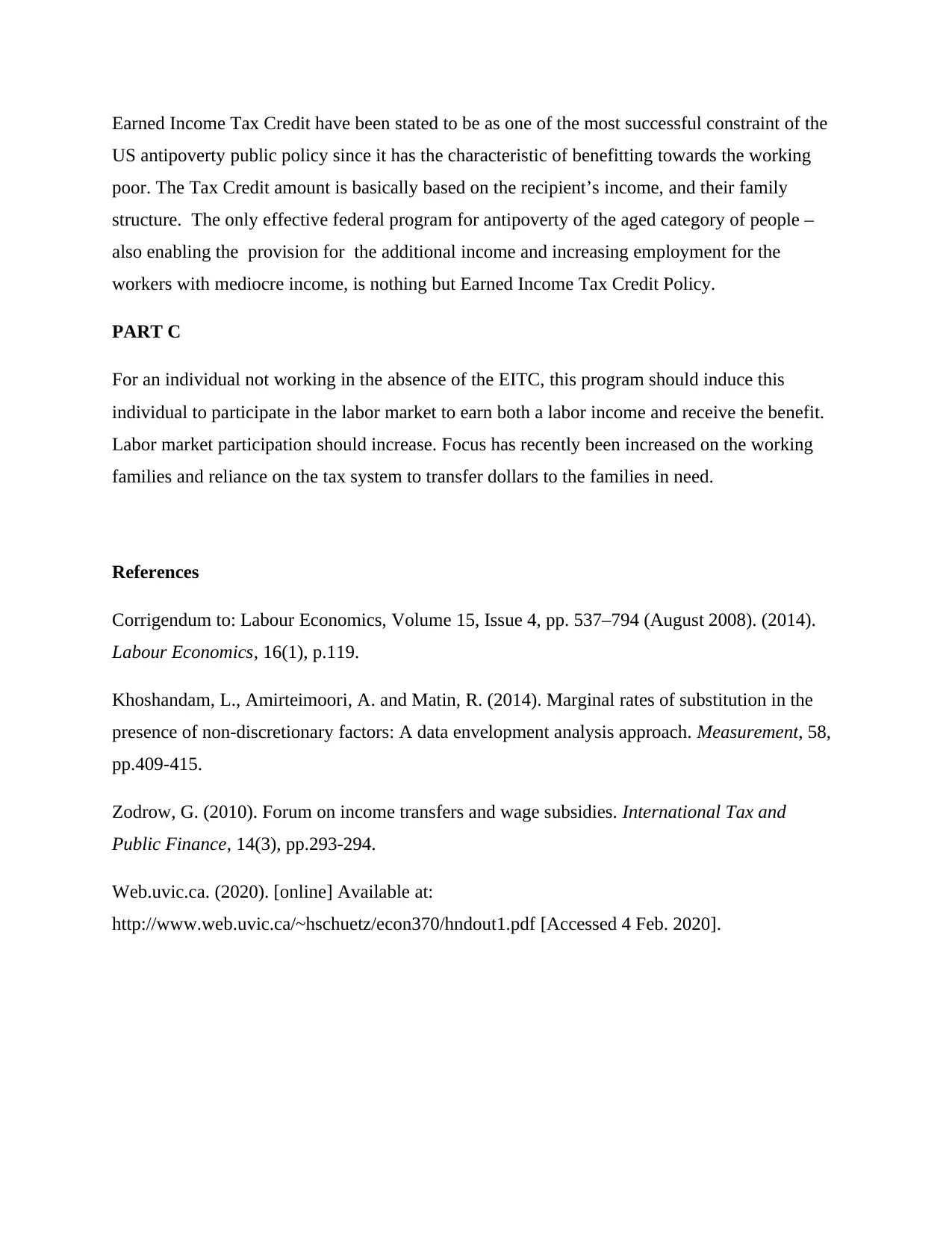
Earned Income Tax Credit have been stated to be as one of the most successful constraint of the
US antipoverty public policy since it has the characteristic of benefitting towards the working
poor. The Tax Credit amount is basically based on the recipient’s income, and their family
structure. The only effective federal program for antipoverty of the aged category of people –
also enabling the provision for the additional income and increasing employment for the
workers with mediocre income, is nothing but Earned Income Tax Credit Policy.
PART C
For an individual not working in the absence of the EITC, this program should induce this
individual to participate in the labor market to earn both a labor income and receive the benefit.
Labor market participation should increase. Focus has recently been increased on the working
families and reliance on the tax system to transfer dollars to the families in need.
References
Corrigendum to: Labour Economics, Volume 15, Issue 4, pp. 537–794 (August 2008). (2014).
Labour Economics, 16(1), p.119.
Khoshandam, L., Amirteimoori, A. and Matin, R. (2014). Marginal rates of substitution in the
presence of non-discretionary factors: A data envelopment analysis approach. Measurement, 58,
pp.409-415.
Zodrow, G. (2010). Forum on income transfers and wage subsidies. International Tax and
Public Finance, 14(3), pp.293-294.
Web.uvic.ca. (2020). [online] Available at:
http://www.web.uvic.ca/~hschuetz/econ370/hndout1.pdf [Accessed 4 Feb. 2020].
US antipoverty public policy since it has the characteristic of benefitting towards the working
poor. The Tax Credit amount is basically based on the recipient’s income, and their family
structure. The only effective federal program for antipoverty of the aged category of people –
also enabling the provision for the additional income and increasing employment for the
workers with mediocre income, is nothing but Earned Income Tax Credit Policy.
PART C
For an individual not working in the absence of the EITC, this program should induce this
individual to participate in the labor market to earn both a labor income and receive the benefit.
Labor market participation should increase. Focus has recently been increased on the working
families and reliance on the tax system to transfer dollars to the families in need.
References
Corrigendum to: Labour Economics, Volume 15, Issue 4, pp. 537–794 (August 2008). (2014).
Labour Economics, 16(1), p.119.
Khoshandam, L., Amirteimoori, A. and Matin, R. (2014). Marginal rates of substitution in the
presence of non-discretionary factors: A data envelopment analysis approach. Measurement, 58,
pp.409-415.
Zodrow, G. (2010). Forum on income transfers and wage subsidies. International Tax and
Public Finance, 14(3), pp.293-294.
Web.uvic.ca. (2020). [online] Available at:
http://www.web.uvic.ca/~hschuetz/econ370/hndout1.pdf [Accessed 4 Feb. 2020].
1 out of 7
Related Documents
Your All-in-One AI-Powered Toolkit for Academic Success.
+13062052269
info@desklib.com
Available 24*7 on WhatsApp / Email
![[object Object]](/_next/static/media/star-bottom.7253800d.svg)
Unlock your academic potential
Copyright © 2020–2025 A2Z Services. All Rights Reserved. Developed and managed by ZUCOL.




